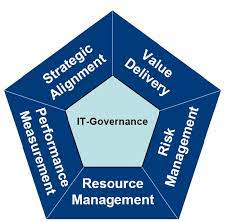The Importance of IT Governance Tools in Modern Businesses
As businesses rely more and more on technology for their operations, the need for robust IT governance tools has become increasingly crucial. IT governance refers to the framework of policies, procedures, and processes that ensure the effective and efficient use of IT resources to achieve business objectives. Implementing the right IT governance tools can help organisations mitigate risks, enhance decision-making processes, and improve overall performance.
Benefits of IT Governance Tools
Risk Management: One of the primary benefits of implementing IT governance tools is better risk management. By having clear policies and controls in place, organisations can identify potential risks proactively and take steps to mitigate them before they escalate into major issues.
Compliance: Compliance with industry regulations and standards is essential for businesses today. IT governance tools help ensure that organisations meet regulatory requirements, such as GDPR or PCI DSS, by providing mechanisms for monitoring and reporting on compliance activities.
Resource Optimization: Effective IT governance tools enable businesses to optimise their use of resources. By aligning IT initiatives with business goals, organisations can avoid unnecessary spending on projects that do not contribute to strategic objectives.
Decision-making: With the help of IT governance tools, businesses can make informed decisions based on accurate data and insights. These tools provide visibility into key performance indicators and metrics that allow stakeholders to assess the impact of IT investments on business outcomes.
Popular IT Governance Tools
ITIL (Information Technology Infrastructure Library): A widely adopted framework for IT service management, ITIL provides best practices for aligning IT services with business needs. Organisations use ITIL tools to improve service delivery, customer satisfaction, and overall efficiency.
COBIT (Control Objectives for Information and Related Technologies): COBIT is a framework developed by ISACA that helps organisations govern and manage their information technology assets effectively. COBIT tools assist in establishing controls, measuring performance, and ensuring compliance with regulations.
GRC (Governance, Risk Management, and Compliance) Platforms: GRC platforms integrate governance, risk management, and compliance activities into a unified solution. These tools streamline processes related to risk assessment, policy management, audit tracking, and regulatory compliance reporting.
In Conclusion
IT governance tools play a vital role in helping businesses navigate the complex landscape of technology while ensuring alignment with strategic objectives. By investing in these tools, organisations can enhance their operational efficiency, manage risks effectively, and maintain compliance with regulatory requirements. As technology continues to evolve rapidly, having robust IT governance frameworks in place will be essential for sustaining business success in the digital age.
Essential Insights into IT Governance Tools: Definitions, Varieties, Optimal Frameworks, and Practical Applications
- What is a governance tool?
- What are the 5 types of IT governance?
- What is the best framework for IT governance?
- What are IT governance tools?
What is a governance tool?
A governance tool is a software solution or platform designed to facilitate the implementation of governance frameworks and processes within an organisation’s IT infrastructure. These tools help businesses establish and enforce policies, procedures, and controls to ensure that IT resources are used effectively and in alignment with business objectives. By providing features such as monitoring, reporting, and automation capabilities, governance tools enable organisations to manage risks, improve decision-making, and maintain compliance with regulatory requirements. In essence, a governance tool acts as a centralised mechanism for overseeing and optimising IT operations to support the overall success of the business.
What are the 5 types of IT governance?
In the realm of IT governance, there are five primary types that organisations commonly utilise to manage their IT resources effectively. These include strategic alignment, value delivery, risk management, resource management, and performance measurement. Strategic alignment focuses on aligning IT objectives with business goals, while value delivery ensures that IT investments yield tangible benefits. Risk management involves identifying and mitigating potential risks to IT systems and data. Resource management pertains to optimising IT resources to support business operations efficiently. Lastly, performance measurement involves tracking key metrics to evaluate the effectiveness of IT initiatives in achieving organisational objectives. By understanding and implementing these five types of IT governance, businesses can enhance their overall performance and achieve greater success in the digital landscape.
What is the best framework for IT governance?
When it comes to selecting the best framework for IT governance, there isn’t a one-size-fits-all answer. Different organisations have unique needs and priorities, which can influence the choice of framework that aligns best with their goals. Some popular frameworks for IT governance include ITIL (Information Technology Infrastructure Library), COBIT (Control Objectives for Information and Related Technologies), and ISO/IEC 27001. Each of these frameworks offers distinct advantages and focuses on specific aspects of governance, risk management, and compliance. It is essential for organisations to evaluate their requirements carefully and consider factors such as industry standards, regulatory obligations, and organisational objectives when determining the most suitable framework for their IT governance needs.
What are IT governance tools?
IT governance tools encompass a set of software solutions, frameworks, and methodologies designed to facilitate the effective management and oversight of IT resources within an organisation. These tools are instrumental in ensuring that IT initiatives align with business objectives, comply with regulatory requirements, and mitigate risks effectively. By providing mechanisms for monitoring performance, enforcing policies, and facilitating decision-making processes, IT governance tools play a crucial role in enhancing operational efficiency and driving strategic value from technology investments. In essence, IT governance tools serve as the foundation for establishing a structured approach to managing IT assets and operations in a manner that supports organisational goals and fosters sustainable growth.

